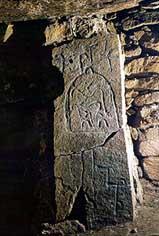- Home
- Discover the megaliths of Morbihan
- Art reflects the sacred
- Main works
- The small stele at Mané-er-Hroeg
Next slide
Previous slide
A photography of the stele before it was taken out to be restored.
Early 20th century moulding and interpretative sketch by Z. Le Rouzic.
Early 20th century moulding and interpretative sketch by Z. Le Rouzic.
Mané-er-Hroeg is a large carnacean barrow. A stele was found, broken in three, in the packing used to close the burial-chamber.
The parallelepiped-shaped, granite stone is 110 cm high, 40 cm wide and 20 cm thick.
The main side, a naturally smooth slab was ornamented over its entire surface. Unfortunately, since its discovery, the stone has been vandalized twice and a part is now missing.
All the main motifs used in Armorican megalithic art can be seen on the stone in a very elaborate pattern.
In the middle of the upper half was engraved a 'shield', topped by four handled axes.
Inside the shield, from top to bottom, can be seen a horn-shaped sign, two crosiers opposite each other and two probably horn-shaped grooves, loosely carved one above the other.
Two handled axes make up the decoration along the edges.
Four handled axes (one of them with an 'axe- plough'-like, basal loop) and an elaborate pattern (mutilated at some early date) were also engraved on the lower part of the stone. The pattern may be a rough drawing of a bovine animal.


